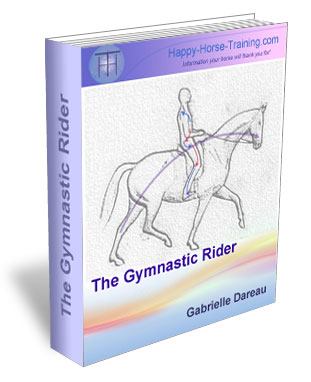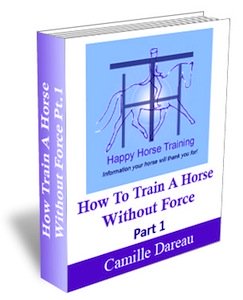| Back to Back Issues Page |
 |
|
The Whole Horse No. 34 - Faith in the Flow February 02, 2014 |
Having Faith in the FlowSpotlight On Management: Recently we put up a polytunnel shelter for our main herd - a 12 meter long arc-shaped structure covered with a tarpaulin. It is open at both ends and there is a connecting lane running down one side.
The first time we introduced the horses to their new shelter, they performed what looked like some kind of ritualistic dance, trotting powerfully and elegantly round and round the path which led through the tunnel and up the side. They went round several times, and it seemed to me as if they were marking the route. In fact, I would go as far as to say that they were opening a route in the energy, because the first time they went round, no one horse wanted to go more than a few metres in the lead. A different leader would feed in as the present leader dropped back - and the completion of the whole route that first time was done with a wild leap, almost as if they had to force the energy to let them through. Thinking about this reminded me of something I learned about horses, that they need a passageway to feel safe. It was something in their spacial awareness that relies on that, an avenue, a pathway, an exit above all. Of course it makes sense: a prey animal always needs an escape route. That made sense of their attitude towards the shelter too - since their path forming ritual, they adore the shelter. They go there to play, to roll, to sleep... and even to shelter! It also makes sense of why horses often choose not to enter three-sided shelters - because there is no clear passageway through, so they cannot relax.
Forcing horses to spend time in a completely enclosed shelter - a stable in other words - where there is no choice to enter or leave, and certainly no open passageway, is probably profoundly disturbing for horses in ways we can't understand - after all humans are sheltering, nesting creatures by nature, and we therefore seek to be surrounded in order to feel safe and protected. 

Our 'white man' culture has been notorious in failing to understand the importance, and the value of flow. We controlled horses from the beginning with ropes and enclosures in varying measures of force, rather than with love and understanding. So our relationships have often been marred by distrust. Cultures who remain closer to nature, such as the Native American Indians, are much more at ease with lack of constraint and liberty in their relationships with animals.
To understand our horses, we must realize that for them, peace of mind relies on the flow of energy. The flow is everywhere, and we are capable of blocking it everywhere also. It flows physically through their bodies, out of their feet into the earth and back. We can block this with metal shoes.
 This horse's energy is able to ground him into the earth through his feet because he is barefoot, as nature intended.
This horse's energy is able to ground him into the earth through his feet because he is barefoot, as nature intended.
This horse (right) does not have this flow of energy through his feet into the ground, because it has been blocked by the energetic barrier of steel shoes and the restrictive effect they have. If we develop our sensitivity to energy flow, we can learn to recognise these differences even in an image - let your eye travel between these two photo's, and see if you can pick up the energy flow. 
 Energy flows through the horse's movement by means of the postural ring.
Energy flows through the horse's movement by means of the postural ring.
We can block this with bits and spurs.
Parallels with Training
Promoting a healthy energetic flow truly is the key to good training. Much training with horses relies on blocking the flow of movement in order to 1) control the horse and 2) alter their balance. In fact blocking the flow of energy in this way takes the trainer further from each of these goals. The only true control we can ever have must be founded on trust, which comes from the rider first. We must allow the flow of movement, and seek control only by re-directing it into a passageway which allows the horse to listen to us better physically. This brings us back round to the second reason for blocking the flow: 'altering the horse's balance' so they will perform different movements.
How Flow Can Be Blocked in the Horse's Movement
Flow is actively blocked in riding by restricting the horse's freedom of movement with the reins (whether using a bit or a bitless bridle), with short side-reins, or any other restrictive 'auxiliary aid'. It is also possible to create a block in the flow of the horse's energy by conditioning the horse's mind and body, so that even when the physical holding is removed, the energetic block remains. This is why horses can be ridden with little or no rein contact, and still have poor energy flow through their body due to a training method which does not promote it. The energy flow in a horse's movement is passively blocked by their natural crookedness, lack of alignment in bending, and any natural lack of balance (e.g. running onto the forehand, disengaging the haunches). This is why training with the goal of gymnastic purity sets out to address these passive obstacles to flow, without creating more obstacles by restricting the movement. The presence of the flow, or transmission, as we often refer to it, feeds the spiral of straightening and re-balancing which is real dressage training. In this way the horse's natural movement is enhanced and empowered.
 In the same way as the tunnel shelter - by creating a channel for the movement with our postural structure and stability, which is open at both ends (free from blocking reins and driving spurs), so that the horse always has the choice to connect with us or not, but which makes a place of comfort and safety because it offers balance and harmony.
In the same way as the tunnel shelter - by creating a channel for the movement with our postural structure and stability, which is open at both ends (free from blocking reins and driving spurs), so that the horse always has the choice to connect with us or not, but which makes a place of comfort and safety because it offers balance and harmony.
This kind of training is profoundly fulfilling and relaxing for horses because it is all about their favourite concern (after the flow of food of course!): the flow of energy within balanced movement - they feel empowered and able to transcend their inherent weaknesses. Being connected to the flow and power that the horse's movement can provide when it is in balance is also profoundly rewarding for humans, because we transcend the limitations of our own bodies, without upsetting our highly-tuned sense of balance, evolved for maintaining equilibrium on two legs. Learning to 'go with the flow', both physically and mentally, is a great lesson for all of us, as part of human nature is often to hold on too much, trapping ourselves in unnecessary limitations. Horses can show us, in so many ways, that flow is the essence of life.
HHT's Try This At Home Tip When you are riding or working with your horse, think about the quality of the 'space' you are creating for him/her with your aids or commands:
Just Click here to go to the HHT group page, and then click on the 'join group' button at the top right of the page.
Sharing the Holistic Message
If you enjoy the Happy Horse Training website, and you find the information on it useful, please help us to share it by clicking on the Facebook 'like' and 'share' buttons that are on each page (you can also share this newsletter by clicking on the symbol above). Any other way you can pass the site on to friends and colleagues, for example via discussion forums, is also greatly appreciated. You can also sign up to our RSS feed (blog) to be kept up to date with new ideas, pages and other information that we post there. Just click on the box that says 'subscribe to this site' at the left of each page. The equestrian world is one dominated by traditionalist ideas and conventions, but we would like to help inform the growing minority of horse-owners who want to make their horses happier with progressive and holistic methods.
Happy Horse Training now has over 100 pages exploring many different areas of holistic equitation. Do have a look through our site plan to find the subjects and categories that interest you.
Available from HHT:
New! The Gymnastic Rider eBook  Available exclusively from HHT, a unique and comprehensive guide to practical rider biomechanics. This professionally produced eBook takes the rider through the process of developing their body in the specific way that brings the horse's movement into harmony and balance, without force and constraint.
Available exclusively from HHT, a unique and comprehensive guide to practical rider biomechanics. This professionally produced eBook takes the rider through the process of developing their body in the specific way that brings the horse's movement into harmony and balance, without force and constraint.
The information in this book, including over 55 000 words, represents what we would normally pass on in a minimum of 12 specialist lunge lessons, focusing on each part of the position and its influence on the horse, with a value of at least €450. The Gymnastic Rider is available for only €29.99. Click here for full details, and to download the 15-page introduction to the book for free.
How to Train a Horse Without Force
eBook With your purchase you will receive a free bonus supplement on Horse Trauma - cutting edge insights on this subject that up until now have mostly been applied only to human trauma. This supplement shows how to recognise, avoid and deal with horse trauma, which is much more common that we realise. These two e-books - How to Train a Horse Without Force and Horse Trauma comprise more than 75 thousand words and are richly illustrated. They are available for only 19.99 Euros (around $26). Click here for more details.
|
| Back to Back Issues Page |





